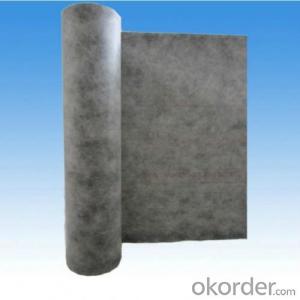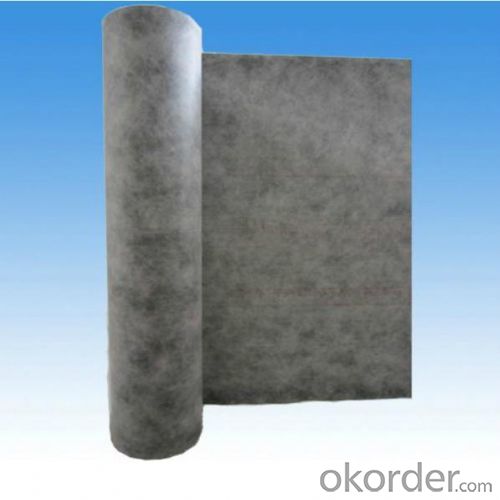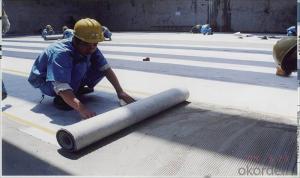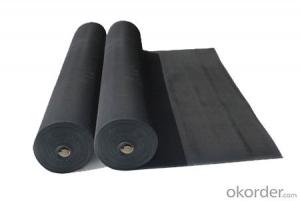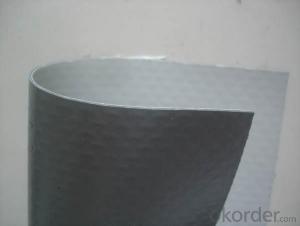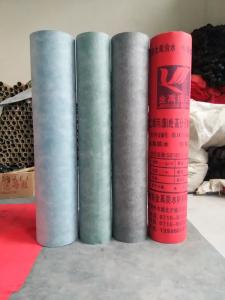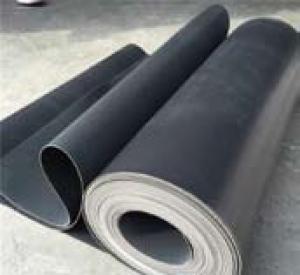High Polymer Waterproof Membrane
- Loading Port:
- China Main Port
- Payment Terms:
- TT OR LC
- Min Order Qty:
- -
- Supply Capability:
- -
OKorder Service Pledge
OKorder Financial Service
You Might Also Like
This product is composed of extruded PE membrane with polypropylene fiber or dacron and self-adhesive covered on both sides of the core membrane as reinforced layer to make it big friction and easy to be stuck firmly to the concrete. With characteristics of easy installation, no pollution and good durability.
Polyethylene polymer waterproofing materials performance index
GB 18173.1-2006
Items | FS2 Resins | Applicable Test Category | |
Tensile Strength(N/cm) | Normal temperature≥ | 60 | GB6.3.2 |
60°C≥ | 30 | ||
Elongation% | Normal temperature≥ | 400 | |
-20°C | 10 | ||
Tear Strength ( N) | ≥ | 20 | GB6.3.3 |
(0.3Mpa.30 min)Water impermeability | No leakage | GB6.3.4 | |
- Q: PVC waterproof membrane effect how
- 4, hot-melt method: the use of flame heater melting hot-melt waterproofing membrane at the bottom of the hot melt adhesive bonding method of construction.
- Q: Can a waterproofing membrane be used in conjunction with tile or stone installations?
- Yes, a waterproofing membrane can definitely be used in conjunction with tile or stone installations. In fact, it is highly recommended to use a waterproofing membrane in wet areas such as bathrooms, showers, and kitchen backsplashes to prevent water damage and moisture penetration. A waterproofing membrane acts as a barrier that prevents water from seeping through the tile or stone and reaching the underlying layers, such as the subfloor or wall. It helps to protect the structure and prolong the lifespan of the installation. There are various types of waterproofing membranes available, including liquid-applied membranes, sheet membranes, and fabric membranes. These membranes can be applied to the substrate before the tile or stone is installed, creating a waterproof layer that ensures the area remains dry and free from water-related issues. Using a waterproofing membrane not only provides protection against water damage but also helps to prevent the growth of mold and mildew, which can be harmful to both the installation and the health of the occupants. It is important to note that the proper installation of the waterproofing membrane is crucial for its effectiveness. It should be applied according to manufacturer guidelines and best practices to ensure a tight seal and complete coverage. Overall, incorporating a waterproofing membrane with tile or stone installations is a wise choice, as it enhances the durability and longevity of the project while providing peace of mind against potential water damage.
- Q: How does a waterproofing membrane handle construction vibrations?
- A waterproofing membrane is designed to handle construction vibrations by providing a durable and flexible barrier that can withstand the movement and impact caused by these vibrations. The membrane is typically made of materials such as rubberized asphalt or synthetic polymers, which have excellent elasticity and tensile strength. When construction vibrations occur, the waterproofing membrane absorbs and dissipates the vibrations, preventing them from affecting the structural integrity of the building or compromising the waterproofing system. The flexibility of the membrane allows it to stretch and contract, accommodating the movement caused by vibrations without cracking or tearing. Additionally, some waterproofing membranes have added features like reinforced layers or fabric reinforcement, which further enhance their ability to withstand construction vibrations. These reinforcements provide additional strength and stability to the membrane, making it more resistant to damage from vibrations. It is important to note that the effectiveness of a waterproofing membrane in handling construction vibrations also depends on the quality of installation. Proper installation techniques, including adequate surface preparation and appropriate adhesion methods, ensure that the membrane is securely attached to the substrate, minimizing the risk of displacement or damage during construction activities. In summary, a waterproofing membrane is specifically designed to handle construction vibrations by absorbing and dissipating the impact, while maintaining its integrity and waterproofing capabilities. The flexibility and strength of the membrane, along with proper installation techniques, ensure that it can withstand the challenges posed by construction vibrations and provide long-lasting protection against water intrusion.
- Q: Does a waterproofing membrane require a primer before application?
- Yes, a waterproofing membrane typically requires a primer before application. A primer helps to enhance the adhesion of the membrane to the substrate and ensures a proper bond between the two. It also helps to seal the surface, preventing any moisture or contaminants from compromising the effectiveness of the waterproofing system. Using a primer before applying the waterproofing membrane is important for achieving a durable and long-lasting waterproofing solution.
- Q: Does a waterproofing membrane require any special cleaning or maintenance procedures?
- Special cleaning and maintenance procedures are necessary for a waterproofing membrane. Although it is designed to resist water and other elements, regular maintenance is crucial to ensure its durability and effectiveness. The specific procedures for cleaning and maintenance may vary depending on the type of waterproofing membrane used. However, it is generally advised to keep the membrane clean and free from debris, such as leaves, dirt, or other foreign objects. This can be achieved by sweeping or gently washing the surface with water and, if needed, a mild detergent. Furthermore, it is essential to regularly inspect the membrane for any signs of damage, such as tears, cracks, or loose seams. If any issues are detected, they should be promptly addressed to prevent water infiltration and further harm. In certain cases, the manufacturer or installer of the waterproofing membrane may recommend specialized cleaning products or treatments. It is important to adhere to their guidelines and recommendations to ensure proper care and maintenance for the specific membrane used. Overall, regular cleaning and maintenance of a waterproofing membrane will prolong its lifespan and guarantee its continued effectiveness in safeguarding the underlying structure from water damage.
- Q: Can a waterproofing membrane be used for bridges or parking decks?
- Yes, a waterproofing membrane can be used for bridges or parking decks. Waterproofing membranes are commonly used in these structures to protect them from water damage and extend their lifespan by preventing water infiltration and corrosion. The membrane acts as a barrier, preventing water from seeping into the structure and causing structural deterioration or compromising the integrity of the bridge or parking deck.
- Q: Can a waterproofing membrane be used in areas with high groundwater levels?
- Yes, a waterproofing membrane can be used in areas with high groundwater levels. In fact, it is highly recommended to use a waterproofing membrane in such areas to protect the structure from water infiltration. A waterproofing membrane is specifically designed to create a barrier against water, preventing it from seeping into the building or structure. This can be particularly important in areas with high groundwater levels, as the pressure from the water can be significant and increase the risk of water damage or flooding. By installing a waterproofing membrane, you can effectively mitigate the risk of water infiltration and ensure the longevity and durability of the structure.
- Q: Can a waterproofing membrane be used in crawl spaces?
- Yes, a waterproofing membrane can be used in crawl spaces to prevent moisture infiltration and protect the space from water damage.
- Q: Can waterproofing membranes be painted over?
- Yes, waterproofing membranes can be painted over. However, it is important to ensure that the paint used is compatible with the membrane material. It is recommended to consult the manufacturer's guidelines or seek professional advice to ensure proper adhesion and longevity of the paint. Additionally, the surface should be clean and dry before applying the paint to ensure optimal results. Overall, painting over a waterproofing membrane can help enhance its appearance and provide additional protection against UV rays and other environmental factors.
- Q: Can a waterproofing membrane be used on copper surfaces?
- Yes, a waterproofing membrane can be used on copper surfaces. Copper surfaces can be susceptible to corrosion and damage from moisture, so applying a waterproofing membrane can provide an added layer of protection. The membrane will create a barrier that prevents water and moisture from penetrating the copper surface, helping to prevent corrosion and prolong the lifespan of the copper material. It is important to choose a waterproofing membrane that is compatible with copper to ensure proper adhesion and effectiveness. Additionally, proper surface preparation and application techniques should be followed to ensure a successful waterproofing solution for copper surfaces.
Send your message to us
High Polymer Waterproof Membrane
- Loading Port:
- China Main Port
- Payment Terms:
- TT OR LC
- Min Order Qty:
- -
- Supply Capability:
- -
OKorder Service Pledge
OKorder Financial Service
Similar products
Hot products
Hot Searches
Related keywords
